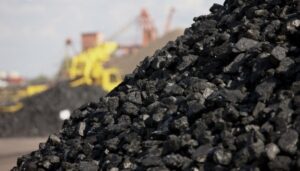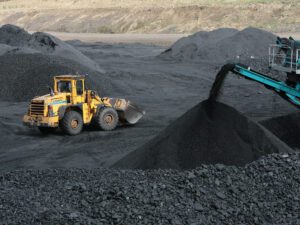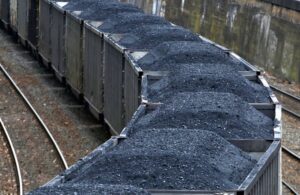
Stocks of coal in the warehouses of thermal power plants of generating companies in Ukraine grew by 5.8% (by 38,300 tonnes) from January 31 to February 7, 2022, to 695,500 tonnes, according to data from the Ministry of Energy.
According to the calculations of Interfax-Ukraine, since the beginning of the year, stocks have grew by 1.6 times (as of December 31, 2021 it were 435,700 tonnes), they are also 1.8 times more than a year earlier (as of February 8 2021 it were 384,400 tonnes).
As reported, the supply of coal to the warehouses of Ukraine’s thermal power plants in January 2022 rose by 8% (by 148,200 tonnes) compared to December 2021, to 1.991 million tonnes, including 643,400 tonnes of imported coal (1.6 times more), 1.347 million tonnes of Ukrainian-made coal (6.5% less).

Ukraine increased imports of hard coal and anthracite by 15.4% in 2021 year-on-year (by 2.612 million tonnes), up to 19.563 million tonnes.
According to the State Customs Service, coal was imported for $2.489 billion, which is 47.2% more than in 2020 ($1.691 billion).
Ukraine received $1.545 billion worth of coal (62.09% of imports) from Russia, $494.636 million (19.88%) from the United States, $253.469 million (10.18%) from Kazakhstan and $195.383 million (7.85%) worth of coal from other countries.

Coal mining enterprises of Ukraine in 2021 increased production of coal by 2% (by 569,500 tonnes) compared to 2020 – to 29.388 million tonnes, according to the data of the Ministry of Energy.
In particular, production of steam coal amounted to 22.153 million tonnes, coking coal – 7.234 million tonnes.
According to the calculations of the Interfax-Ukraine agency, coal mining enterprises, which are part of the ministry’s sphere of management, last year increased production by 1.9 times – up to 5.446 million tonnes, which is largely due to the return from the lease by DTEK of the assets of state enterprise Dobropilliavuhillia.
The mines of Donetsk region in 2021 ensured the production of 11.892 million tonnes of coal (up 5.7% from 2020), Luhansk region – 257,600 tonnes (up 14.2%), Dnipropetrovsk – 16.032 million tonnes (up 0.2%), Lviv – 1.182 million tonnes (down 9.7%), Volyn – 24,400 tonnes (down 28.5%).
In December 2021, production of coal in the country increased by 5.8% compared to the same month in 2020 – to 2.772 million tonnes.

DTEK Energy expects two more ships with 147,000 tonnes of thermal coal from Colombia and the United States to arrive in Ukraine by the end of the week, the company’s press service said.
According to its data, the first ship with 75,000 tonnes of coal from Colombia will arrive at the port of Chornomorsk next Friday, the second – with 72,000 tonnes from the United States will be moored at the TIS port at the weekend.
Coal from the fifth and sixth Panamax class ships that have arrived since the end of November will replenish the warehouses of the company’s TPPs.
“DTEK Energy continues to actively supply coal to the Ukrainian energy system. In addition to the four Panamax ships with imported coal, which have already arrived, have been fully unloaded or are now being sent to Ukrainian thermal power plants, we meet two more ships,” DTEK Energy CEO Ildar Saleev said.
In addition, the company has agreed on an additional ninth vessel. In general, this is about 618,000 tonnes of coal for the needs of Ukrainian thermal power plants. The first ship contracted by the company for the needs of the state-owned TPPs of Centrenergo arrived in Ukraine on November 20. The second, third and fourth Panamax ships with coal for DTEK Energy TPPs arrived on December 5, 16 and 17.
Since the beginning of December, the company has already imported about 200,000 tonnes of coal by sea. For the stable passage of the heating season, the company has contracted more than 1 million tonnes of imported fuel to date.
DTEK Energy is an operating company in charge of coal mining and electricity production from coal within the structure of Rinat Akhmetov’s DTEK Holding.

Pavlohradvuhillia and Bilozerska mines, which are part of DTEK Energy, produced 15.2 million tonnes of coal in January-November 2021, which corresponds to the same production volume for the same period in 2020, the press service reported.
In November 2021, production amounted to about 1.5 million tonnes against 1.3 million tonnes in November 2020 (excluding Dobropilliavuhillia, already returned from lease).
DTEK Energy commissioned 28 new longwalls at its mines in 11 months, in November – five.
“DTEK Energy continues to produce maximum coal at its own mines. This is very important for the stability of the Ukrainian energy system during peak periods of consumption. In November, we produced about 1.5 million tonnes of G grade coal and put into operation five new longwalls. Also, the Dniprovske and Heroiv Kosmosu mine administrations have fulfilled the annual production plan ahead of schedule and continue to increase it to the maximum,” CEO of the company Ildar Saleev said.
As reported, DTEK Energy plans to ensure the production of about 17 million tonnes of coal in 2021.
DTEK Energy is an operating company responsible for coal extraction and enrichment, maintenance of mine equipment and power generation in the structure of DTEK Holding of Rinat Akhmetov.

Ukraine in January-October 2021 increased imports of hard coal and anthracite (heading code 2701) by 14.8% (by 2.064 million tonnes) compared to the same period in 2020, to 16.03 million tonnes. According to the State Customs Service, coal was imported for $1.741 billion, which is 21.6% more than in January-October 2020 ($1.432 billion).Coal was received from the Russian Federation for $1.141 billion (share in imports 65.54%), the United States for $322.306 million (18.51%), Kazakhstan for $195.42 million (11.22%), and other countries for $82.329 million (4.73%). Coal exports by Ukraine in January-October 2021 amounted to 4,982 tonnes for $0.8 million, including to Slovakia for $0.768 million, Hungary for $0.018 million, Bulgaria for $0.007 million, other countries for $0.007 million. For the same period of 2020, exports amounted to 2,255 tonnes for $0.186 million, including to Poland for $0.156 million, Moldova for $0.027 million, and Hungary for $0.004 million.